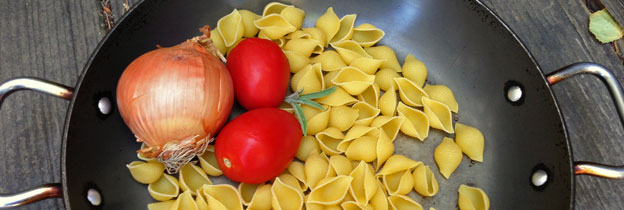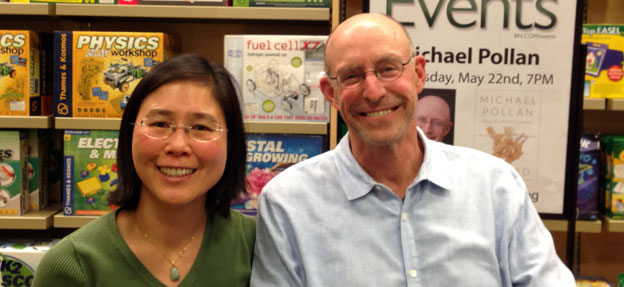Skip the preliminaries; go directly to the recipe for pasta, cannellini beans, bacon, and sage soup
School’s out this week. The DD is immediately plunging into an intensive summer course to learn a year’s worth of Japanese in 6 weeks, and the DS is whiling away the week learning how to survive on a deserted island. Don’t ask me; this is their idea of fun. I generally let them choose summer camps and activities that they want to do, but this summer, I’m also asking them to plan on cooking one meal once every other week. I tried to suggest that they do it once a week, but a tidal wave of groans and complaints drowned me out.
The rules are simple. It can be any meal of the day, as long as it involves planning and cooking. Making a cheese sandwich does not count, unless they make the bread and the cheese. OK—maybe not the cheese. But it needs to be a well-balanced meal with carbs, protein, and vegetables (or fruits). That cheese sandwich would need to be accompanied by a salad, or have lots of veggie toppings in addition to the cheese. Heating up leftovers does not count. The meal can be something that they have had in the past; it does not have to include dessert. We adults will shop for the ingredients once they’ve supplied a list of what they need, and we’ll supervise and help, but they will be in the driver’s seat.
I keep trying to create opportunities for my kids to learn and practice cooking skills because when they leave home (for college, I hope!), basic cooking know-how should be among the life skills they have: that and not turning their white t-shirts pink in the laundry (not that I did that two weeks ago), cleaning up after themselves, taking public transportation, managing money, having healthy relationships…. can I lock them up in a closet yet?
Anyway, I thought I had cooking—at least—covered. For a couple of years, we organized a Lunch Club with a group of my friends’ kids. They had to present recipe ideas, create a balanced meal plan, make sure the ingredients came in within budget ($5 per person, which we adhered to strictly), cook the meal (without adult help, at least in theory), and clean up (the last was mostly theoretical, since the moms couldn’t seem to help ourselves, and we’d end up cleaning up when the kids melted away to play capture-the-flag). The kids made luxurious meals, like fettuccine with peas, asparagus, and pancetta; roasted baby vegetables; and strawberries with chocolate caramel sauce. Or like fresh tomato salsa on cheese-and-spice tortilla chips; flank steak with corn-tomato relish and grilled garlic bread; and fruit salad with citrus syrup. There were very few dishes that were off the mark, only one cut finger, and no burns. But within two years of the Lunch Club’s demise, the DD seems to have forgotten how to measure flour and the DS is afraid to handle an 8” chef’s knife! Sigh—one step forwards and two steps back.
So I’m back, encouraging them to take up cookbooks and colanders again. Don’t tell them, but I hope this is a habit they will continue even after school starts again! The DD has nominated pasta, cannellini beans, bacon, and sage soup as the first main course they make. It’s one of their favorite dishes, and always among the first ones they request when asked to give input on the weekly menu plan. They’ll have to add on a vegetable side dish, and decide whether to do a dessert or not. Hmmm… I wonder if they remember how to make chocolate lava cakes with whipped cream like they did for Lunch Club?
Recipe: Pasta, cannellini beans, bacon, and sage soup
Makes 4 generous servings
This recipe is adapted from Beans & Rice by Joanne Weir (Williams-Sonoma Kitchen Library, 1994). The ingredient quantities are flexible; feel free to put in more or less of any particular ingredient to suit your taste!
Ingredients
- 2 cups dried cannellini beans
- 1 tablespoons extra-virgin olive oil
- 4 ounces lean bacon, thinly cut crosswise
- 1 medium yellow onion, chopped
- 3 cloves garlic, minced
- 1 (28-ounce) can diced tomatoes
- 2 tablespoons fresh sage, chopped
- ¼ teaspoon red pepper flakes
- 4 cups low-sodium chicken broth, plus additional if desired
- 8 ounces dried pasta, such as shells
- salt and freshly ground black pepper, to taste
- for serving: freshly grated Parmesan cheese
Preparation
Make the beans. Pick over and discard any stones or damaged beans. Put the beans in a colander and rinse them with water. Transfer them to a large bowl, cover with water by 2 inches, and allow them to soak for at least 3 hours or overnight. Alternatively, quick-soak the beans by transferring them to a medium saucepan; add water to the saucepan to cover the beans by 2 inches. Bring the beans to a boil, cover the saucepan, turn off the heat, and allow the beans to soak for 1 to 1-½ hours.
After soaking, drain the beans, put them into a medium saucepan, cover the beans with water by 2 inches again, then bring the water to a boil. Boil the beans, uncovered, for 5 to 10 minutes, then turn the heat down to low, and simmer the beans until they are soft and cooked through, approximately 1 hour. Check the beans as they cook to make sure they are always completely covered by water, adding more water if necessary. Beans may be prepared in advance. Cool completely, and store in cooking liquid, tightly covered. Drain the beans, and proceed with the recipe.
Make the soup. In a 4-6 quart soup pot over medium-low heat, warm the olive oil until it shimmers. Add the bacon, onion, and garlic; sauté until bacon and onion begin to brown, about 10 minutes. Add the tomatoes, sage, and red pepper flakes, and bring to a brisk simmer; turn the heat to low, and simmer for 15-20 minutes, stirring occasionally. Turn the heat up to medium-high, and add the broth and beans. Return the soup to a slow boil, then turn the heat back down to low, cover partway, and simmer for another 15-20 minutes to meld the flavors, stirring occasionally. Turn the heat up to medium-high, and bring the soup up to a slow boil, add the pasta, and cook until the pasta is al dente. Add more broth or water to thin the soup if it is too thick. Add salt and pepper to taste.
Serve the soup, hot, with Parmesan sprinkled on top.
Tips: Substitute 2 (15-ounce) cans of cannellini beans for the dried beans; drain and rinse the beans before proceeding with the recipe. If you have fresh tomatoes and homemade broth, substitute them for the canned ingredients.






